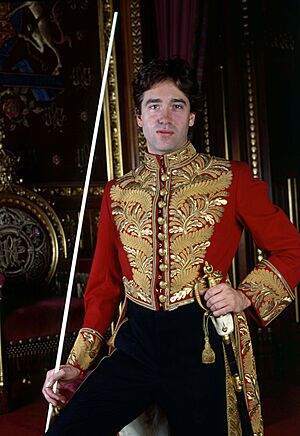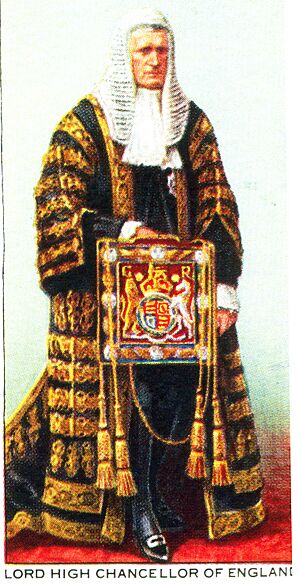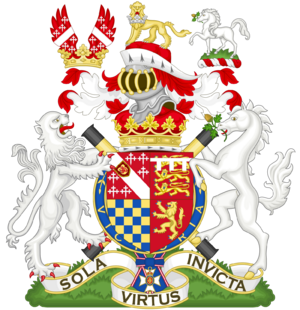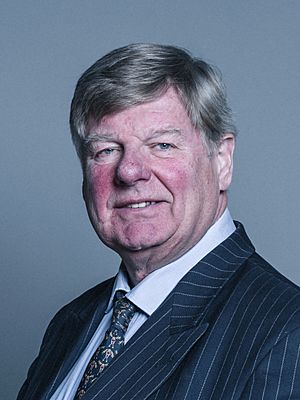Great Officers of State (United Kingdom) facts for kids

In the United Kingdom, the Great Officers of State are important traditional ministers of the Crown. Some of these roles are passed down through families (inherited), while others are appointed by the government. They mostly handle special ceremonies or work as part of the government. There are different Great Officers for England and Wales, and for Scotland. Some roles cover all of Great Britain and the United Kingdom.
England's Great Officers
After the Norman Conquest, England copied some important roles from the French court. These included a steward, a chamberlain, and a constable. At first, these officers managed both the royal household and government tasks. Over time, some of these jobs split into two: one part became a Great Officer of State, and the other became part of the royal household. This happened because many of these jobs became hereditary, meaning they were passed down in families. This made them less involved in the day-to-day running of the country. Today, most of these Great Officer roles are mainly for ceremonies.
| Order | Office | Who holds it now | What it became | Royal Household link |
|---|---|---|---|---|
| 1 | Lord High Steward of England | — | Chief Justiciar (no longer exists) | Lord Steward of the Household |
| 2 | Lord High Chancellor of Great Britain
Lord High Chancellor of England |
Alex Chalk MP for Cheltenham (Secretary of State for Justice) |
— | — |
| 3 | Lord High Treasurer of the United Kingdom
Lord High Treasurer of Great Britain |
— | Prime Minister of the United Kingdom and First Lord of the Treasury
Chancellor and Under-Treasurer of His Majesty's Exchequer and Second Lord of the Treasury |
— |
| 4 | Lord President of the Council | Penny Mordaunt MP for Portsmouth North (Leader of the House of Commons) |
— | — |
| 5 | Lord Keeper of the Privy Seal | Nicholas True Baron True (Leader of the House of Lords) |
— | — |
| 6 | Lord Great Chamberlain of England | Passed down: Rupert Carington 7th Baron Carrington |
Lord High Treasurer (for money matters) | Lord Chamberlain of the Household |
| 7 | Lord High Constable of England | — | Earl Marshal (for leading troops) | Master of the Horse to His Majesty |
| 8 | Earl Marshal of England
Lord Marshal of England |
Edward Fitzalan-Howard 18th Duke of Norfolk |
— | |
| 9 | Lord High Admiral of the United Kingdom
Lord High Admiral of Great Britain |
— | — | — |

Lord High Steward
The Lord High Steward (officially the Lord High Steward of England) used to be the only person who could lead trials of noble people (peers) if they were accused of a crime. The last such trial was in 1806. Today, the most visible job of the Lord High Steward is to carry St Edward's Crown during the coronation of a new monarch. This is a purely ceremonial role.
This role was held by the Earls of Leicester until 1399. After that, the job became part of the Crown. Since 1421, the office is only filled for coronations and, in the past, for trials of peers. Otherwise, it is left empty.
Lord High Chancellor
The Lord Chancellor (officially the Lord High Chancellor of Great Britain) is the most important Great Officer, apart from the Lord High Steward. The Lord High Steward is only appointed for special events like coronations. The Lord Chancellor is a cabinet minister in charge of the Ministry of Justice. They are also the official keeper of the Great Seal, which is used to approve important government documents.
Today, this job is always held by the Secretary of State for Justice. In the past, the Chancellor had many duties related to the courts. They also led meetings in the House of Lords. Since 2007, only people who are not nobles have been appointed to this office.
The Lord Keeper of the Great Seal was a temporary job. This person would look after the Great Seal until a new High Chancellor was appointed. Eventually, the Lord Keeper had the same importance as the Chancellor. By the late 1700s, the Lord Keeper's role was combined with the Chancellorship. Sometimes, a group of people called Lords Commissioners of the Great Seal are appointed to do the Lord Chancellor's job. The Lord Chancellor gets help with the Great Seal from the Clerk of the Crown in Chancery.
The Chief Justiciar used to be more powerful than the Lord High Chancellor. But by 1231, this position lost its importance. After the Constitutional Reform Act 2005, some of the Lord Chancellor's roles were taken over by the Lord Chief Justice of England and Wales (who leads the courts) and the Lord Speaker (who leads the House of Lords).
Lord High Treasurer
The Lord High Treasurer (officially the Lord High Treasurer of the United Kingdom) is in charge of the government's money and how it is spent. This job has been empty since 1714.
In 1816, the jobs of Lord High Treasurer of Great Britain and Lord High Treasurer of Ireland were combined. The King or Queen can now give the powers of the Lord High Treasurer to a group of people called the Lords Commissioners of His Majesty’s Treasury. This group includes the Prime Minister (who is the First Lord of the Treasury) and the Chancellor of the Exchequer (who is the Second Lord of the Treasury). Other junior government members also serve as junior lords.
Lord President of the Council
The Lord President of the Council leads His Majesty's Most Honourable Privy Council, also known as the Privy Council. Different governments have given this role extra duties. For example, Churchill did this after the Second World War. Since 1951, this job is usually held by either the Leader of the House of Commons or the Leader of the House of Lords. The other person usually serves as Lord Privy Seal. However, the job can also be given to other senior government ministers.
Lord Privy Seal
The Lord Privy Seal (officially the Lord Keeper of His Majesty's Privy Seal) used to be in charge of the monarch's privy seal. This seal is no longer used, so the job is now mostly honorary. It is usually given to the Leader of one of the Houses of Parliament.
Lord Great Chamberlain
The Lord Great Chamberlain (officially the Lord Great Chamberlain of England) originally handled money matters for the royal court. These duties are now done by the Lord High Treasurer. The Chamberlain is also in charge of the Palace of Westminster (where Parliament meets). He helps with arrangements for the State Opening of Parliament, sharing this role with the Earl Marshal.
This job was first held by the Earls of Oxford. Later, it was passed down through the families of the Earl of Lindsey and then the Dukes of Ancaster and Kesteven. In 1780, the House of Lords decided that two sisters who were heirs could share the job. They could appoint someone else to do the actual work. The same rule was used in 1902. In 1912, an agreement was made that the job would rotate among the different families every time a new monarch came to the throne.
The House of Lords Act 1999 removed the automatic right for hereditary nobles to sit in the House of Lords. However, the Lord Great Chamberlain and the Earl Marshal were allowed to keep their seats. This was so they could continue their ceremonial duties in the House.
Lord High Constable
The Lord High Constable (officially the Lord High Constable of England) used to be the commander of the royal armies. He also worked with the Earl Marshal to lead the Court of Chivalry, which dealt with matters of honour. This job was passed down through the Earls of Hereford. But in 1512, the job went back to the Crown. Now, it is only brought back for the day of a coronation, where the Constable commands all the troops involved. The Earl Marshal of England took over the Constable's role in leading the royal armies within the palace.

Earl Marshal
The Earl Marshal (officially the Earl Marshal and Hereditary Marshal of England) was originally in charge of the monarch's horses and stables. He also helped lead the royal armies, sharing these duties with the Constable. His duties have changed over time. Now, he is mainly responsible for organizing big state ceremonies. These include coronations, state funerals, and the State Opening of Parliament.
The Earl Marshal also oversees the College of Arms. This is where official coats of arms are granted in England, Wales, and Ireland. The King's High Court of Chivalry, which deals with all matters related to heraldry (coats of arms and family symbols), is led by the Earl Marshal.
Lord High Admiral
The Lord High Admiral (officially the Lord High Admiral of the United Kingdom) is the ceremonial head of the Royal Navy. This person does not command ships at sea. Instead, they oversee matters related to the sea, including naval courts. The job is usually held by the King or Queen. Sometimes, it is given to other people, often members of the Royal Family. Historically, a group called the Board of Admiralty also held this power.
Scotland's Great Officers
In Scotland, the term "officer of state" is sometimes used for any important job under the Crown. Like in England, many of these jobs are hereditary, meaning they are passed down through families. Several historical jobs ended around the time of the Treaty of Union 1707. There are also other important officers of the Crown and the Royal Household.
Officers of State
| Order | Office | Who held it in 1707 | Who holds it now | Notes |
|---|---|---|---|---|
| More Important Officers of State | ||||
| 1 | Lord High Chancellor of Scotland | James Ogilvy 1st Earl of Seafield |
— | Combined with the Lord High Chancellor of England in 1701 to create the Lord High Chancellor of Great Britain. |
| 2 | Lord High Treasurer of Scotland | A group of people: Commissioners of the Treasury of Scotland — James Ogilvy David Boyle The Honourable |
— | Combined with the Lord High Treasurer of England in 1701 to create the Lord High Treasurer of Great Britain. |
| 3 | Lord Keeper of the Privy Seal of Scotland | James Douglas 2nd Duke of Queensberry |
— | Empty since 1921. |
| 4 | Lord Secretary of Scotland | Hugh Campbell 3rd Earl of Loudoun |
— | Job ended in 1709. |
| Less Important Officers of State | ||||
| 5 | Lord Clerk Register | David Boyle 1st Earl of Glasgow |
Elish Angiolini | Since 1817, also the Keeper of the Signet in Scotland. |
| 6 | Lord Advocate | Sir James Stewart | Dorothy Bain | — |
| 7 | Lord Treasurer-depute | David Boyle 1st Earl of Glasgow |
— | Job ended by the Acts of Union 1707. |
| 8 | Lord Justice Clerk | Adam Cockburn Lord Ormiston |
Leeona Dorrian Lady Dorrian |
— |
| Officers of State that no longer exist | ||||
| n/a | Comptroller of Scotland | — | — | Merged into the Lord High Treasurer of Scotland job. |
| n/a | Master of Requests for Scotland | — | — | Merged into the Lord Secretary of Scotland job. |
Officers of the Crown
| Order | Office | Who holds it now | Notes |
|---|---|---|---|
| 1 | Lord President of the Council of Scotland | — | The Privy Council of Scotland ended in 1708. |
| 2 | Lord High Chamberlain of Scotland | — | Given back to the Crown in 1703. |
| 3 | Lord High Steward of Scotland | Prince William The Duke of Rothesay as Prince and Great Steward of Scotland |
Combined with the Lord Steward job. Later, it became part of the Crown when Robert II became King of Scotland. Now, it is given to the heir to the throne, currently the Duke of Cornwall. |
| 4 | Lord High Constable of Scotland | Merlin Hay 24th Earl of Erroll |
Held by the Hay family of Erroll since the 12th century. |
| 5 | Knight Marischal of Scotland | — | Empty since 1863. |
| 6 | Earl Marischal of Scotland | — | The job was taken away from George Keith, 10th Earl Marischal in 1716. It has not been given back. |
| — | Lord High Admiral of Scotland | Given back to the Crown in 1703 and ended in 1707. | |
| — | Keeper of the Great Seal of Scotland | John Swinney MSP for Perthshire North |
Held by the Secretary of State for Scotland (1926–1999). Since 1999, it is held by the First Minister. |
History of Scottish Officers

After some changes in France, Scotland also created similar important roles. These included a high constable, a high admiral, a great chancellor, a great justiciar, a great chamberlain, a great protonotary, and a great steward. By the time of King Malcolm II, the great protonotary job was gone. The great justiciar was replaced by the Lord Justice General.
The job of High Constable is held by the Earls of Erroll. The heads of the Keith family used to hold the job of Earl Marischal. But in 1716, the person holding it was found guilty of treason, so the job was taken away and has not been given back. The Dukes of Argyll are the Hereditary Masters of the Household. All other officers are appointed by the Crown. Many of these jobs, though once very powerful, are now only for ceremonial events.
The remaining officers are connected to Scotland's judiciary (legal system). The Lord Justice General was once a very important noble. In the 1800s, this job was combined with the Lord President of the Court of Session. Now, the Lord Justice General is the head of Scotland's legal system. The Lord Clerk Register has various duties, including managing elections for Scottish nobles and recording births and deaths. The Lord Advocate leads Scotland's law offices. All prosecutors (lawyers who bring cases against people) act in their name. The Lord Justice Clerk helps the Lord Justice General. Finally, the Lord Lyon King of Arms is the only judge in the Lyon Court. This court decides cases about heraldry (coats of arms).
Before the Union of 1707, Scotland had eight officers of state. Four were more important, and four were less important. Two jobs, Comptroller and Master of Requests, were combined with the Lord High Treasurer and Lord Secretary roles. The more important officers were the Lord High Chancellor, Lord High Treasurer, Lord Privy Seal, and Lord Secretary. The less important officers were the Lord Clerk Register, Lord Advocate, Lord Treasurer-depute, and Lord Justice Clerk.
Several jobs ended around the time of the Union in 1707. These included the High Chancellor, the High Treasurer, the Secretary of Scotland, the Treasurer-depute, the President of the Privy Council, and the High Admiral of Scotland.
See also




